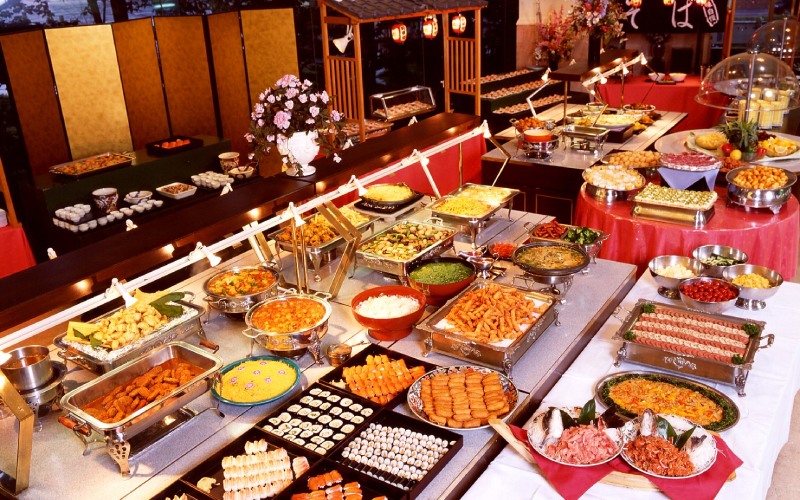 Buffet dining is a popular concept these days
Buffet dining is a popular concept these days
Buffet is currently a very popular dining style in Vietnam, offering a range of price points and diverse cuisines. What is a buffet, what are the common types of buffets, and what are the things to note when dining at a buffet? In today’s article, we will answer these questions. Let’s find out!
1 What is a Buffet?
What is a Buffet?
Buffet is a dining style that originated in the West. In French, the word “buffet” means “standing party” or “freedom“. This meaning also explains the concept of this dining style.
A buffet is known as a dining event where guests can walk around, sit, or get food as they please, with food displayed on tables for guests to help themselves.
During the event, guests are free to mingle and interact with one another in a relaxed and cheerful atmosphere, and the dining experience can last for an extended period.
Here, guests will pay a fixed price per person and can enjoy unlimited food from the chosen menu.
 Buffet dining allows guests to walk around, sit, or get food as they please
Buffet dining allows guests to walk around, sit, or get food as they please
Origin of Buffet
Some research suggests that the buffet originated with the European nobility in the 17th century. It is a spontaneous concept with a strong French influence. Initially, it was a way to handle unexpected parties without prior preparation, and later it became a dining style that could serve a large number of people at the same time.
2 Common Types of Buffets in Vietnam
Today, buffets are popular in many parts of the world, including Vietnam, with a variety of dishes ranging from savory to sweet, and from Western to Asian cuisines, depending on your preferences.
 Common types of buffets in Vietnam
Common types of buffets in Vietnam
Classification by Service Style
- Sit-down Buffet: This is a large buffet where the event space includes food stations and pre-set tables. Guests dine at their tables and are served by waitstaff.
 Sit-down Buffet
Sit-down Buffet
- Standing Buffet: This type of buffet is more flexible and does not require pre-set tables. Guests choose their food and eat with utensils in hand, also serving themselves drinks.
 Standing Buffet
Standing Buffet
- Cocktail Buffet or Finger Buffet: This is a light buffet commonly used for small gatherings. The food items are designed to be small and easy to eat in one bite.
 Cocktail Buffet
Cocktail Buffet
Classification by Cuisine
- Japanese Buffet: Japanese buffets feature traditional dishes from Japan such as sushi, sashimi, and Wagyu beef.
- French Buffet: French buffets often emphasize the ambiance of the event, from the food displays to the presentation of the dishes, which is elegant and eye-catching. The dessert selection typically includes well-known French pastries presented in a distinctive French style.
- Korean Buffet: Korean buffets are famous for their barbecue options, offering a variety of meats and rich dipping sauces. Kimchi is also a signature item in Korean buffets.
Additionally, different countries have their unique buffet styles, reflecting their distinct and rich culinary traditions.
 Buffets showcasing different cuisines
Buffets showcasing different cuisines
Classification by Food Preparation
- Hot Pot Buffet: At hot pot buffets, you will find a variety of broths to choose from, such as spicy and sour, tomato, herbal, and bone broths. You can select various meats, seafood, vegetables, and other toppings to cook in the broth according to your taste and creativity.
- Grill Buffet: With grill buffets, you will be provided with a hot charcoal grill. You can choose from a selection of meats, fish, seafood, and vegetables to grill to your liking. Grill buffets also offer a variety of marinades and dipping sauces with distinctive flavors.
- Combined Hot Pot and Grill Buffet: This type of buffet combines the above two styles, satisfying guests who want to enjoy both grilled meats and hot pot.
 Grill Buffet
Grill Buffet
Classification by Food Characteristics
- Vegetarian Buffet: In addition to the savory buffets mentioned above, vegetarian buffets are also gaining popularity. With the desire to cleanse the body, feel “light”, aid digestion, or simply try something different, vegetarian buffets are becoming more common, offering a diverse range of delicious and nutritious dishes.
 Vegetarian Buffet
Vegetarian Buffet
- Dessert Buffet: Dessert buffets are extremely popular among young people, especially those with a sweet tooth. Here, guests can indulge in a variety of cakes, pastries, tarts, pies, and other sweet treats.
 Dessert Buffet
Dessert Buffet
3 Things to Note When Dining at a Buffet
Take a Moderate Amount of Food
Avoid taking too much food at once, as it may leave others without a share, and it is also wasteful if you cannot finish it. Recently, some buffet restaurants have implemented a rule against leaving uneaten food, with a fine for doing so. Therefore, it is best to take a moderate amount of food, just enough for one serving, and go back for more if you wish.
 Take a moderate amount of food
Take a moderate amount of food
Take a Small Portion of Unfamiliar Dishes
When dining at a buffet, there will likely be dishes that you absolutely love and some that you have never tried before. If you want to try something new, take a small portion first, and if you enjoy it, you can always go back for more.
 Take a small portion of unfamiliar dishes
Take a small portion of unfamiliar dishes
Eat Slowly and Avoid Rushing
Don’t eat too quickly; instead, take the time to chat with those around you and enjoy the atmosphere. Also, avoid rushing or jostling for food, and leave some for others. Buffets are best suited for those with ample time, ideally at least two hours.
Finally, choose a reputable establishment to ensure a quality, nutritious, and enjoyable dining experience with your friends and loved ones.
In conclusion, through this article, you now know what a buffet is, the different types of buffets, and the things to note when dining at a buffet to become a sophisticated and wise diner. We hope you found this information interesting and useful!






























